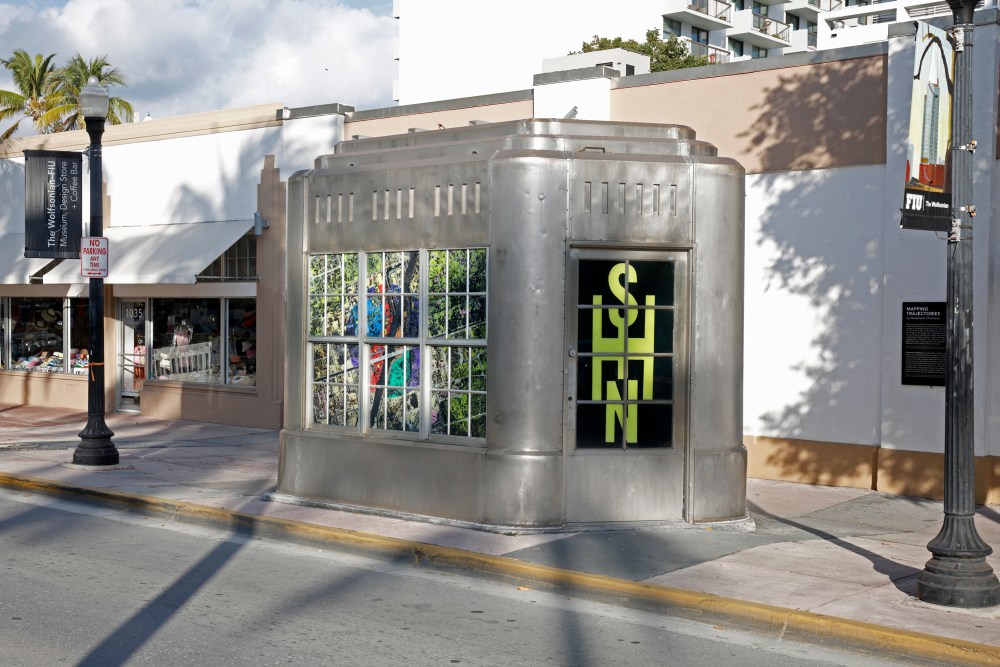The Bridge Tender House is a streamlined-style, stainless-steel building from which bridge tenders once operated a drawbridge over the Miami River. It was installed in 1939 and partially funded by the Public Works Administration, a program within President Franklin Roosevelt’s New Deal to help the nation recover from the Great Depression. The structure is a showpiece of Art Deco design. Saved from destruction in 1993, it was donated to the Wolfsonian-FIU Museum in Miami Beach, where it stands in front of the main building and is used for various projects. Currently at the Bridge Tender House, artist Rosemarie Chiarlone‘s Mapping Trajectories.
The exhibit explores the metaphor of “journey” through the Bridge Tender House’s own relocation. “[T]he work I created for the [BTH] installation transformed into a unique artist’s book, Tender, that is displayed in the museum,” Chiarlone told me. The book includes text by poet Susan Weiner. The method of creating the text is known as the “pinprick”, which makes perforations that express the feeling of absence and loss through holes that allow light to gradually reveal the words of the poem.
Chiarlone also produced an unbound edition printed on newsprint. “A bold typographic design” alters the look and feel of the poem, which relates to the journey of the tender to its current location.
I asked Chiarlone to help us understand this site/sight-specific work and how she expects the viewer to decode and investigate what she calls “the fluid tension between presence and impermanence of the physical and psychological self.”
Photos: Lynton Gardiner
Can you give the reader a verbal description of your exhibition titled Mapping Trajectories at the Wolfsonian-FIU Museum in Miami Beach?
Mapping Trajectories explores the meaning of “journey” in historical and geographical contexts while acknowledging the fragility of man-made objects in contemporary society. It is a two-part installation that traces the Bridge Tender House from the Miami River to its current site in front of The Wolfsonian-FIU. The windows of the Bridge Tender House are a blend of poetry, painting and textural design. The image on the large window facing west refers to its placement on the Miami River, while the window facing east is the Bridge Tender House’s current location. [The] Textural poetic design is WATCHFUL WAITING SEEN CONNECTED.
Additionally, you’ve produced a handmade, artist’s book, which is more like a sculpture, as well as a tabloid newspaper. How does text fit into your project?
As is my practice, the installation transformed into a unique artist’s book entitled Tender, featuring text by poet Susan Weiner, my long-time collaborator:
From river to beach
Manual touch
Watchful Waiting
Flash-drive
Across bay
Over time
New horizon
Sand, sidewalk, sea
Seen, connected
The words are inscribed using pinprick perforations, an ancient paper art form. The method of creating the text by pinprick expresses the feeling of absence and loss through the holes. My works on paper and book art incorporate and often center on representing language in evocative, abstract, poetically coded messages that are obscured or challenging to decipher, to be reconstructed and expanded by the viewer’s own process of decoding.
Can you expand on the “pinprick” method?
My use of perforating paper by hand was inspired by the history of American pinprick art created by women to remedy the evils of slavery and racism that traces back to the 1830s and 1850s, which portrayed slaves in white, pinprick clothing with delicate patterns, representing attempts to develop hope. The absence of imagery, created by my use of deliberate, bi-directional pinpricks or the erasure of visual identifiers, underlines the fragility of the human condition in contemporary society, prompting the viewer to question.
You were influenced by Sonia Delaunay’s La Prose du Transsiberien. How does this show up in the work?
The tabloid Tender incorporates the same poetic text, but in a bold, typographic design. I was inspired by La Prose du Transsiberien, a book in The Wolfsonian-FIU Collection that maps a journey in text and image. Unfolded, the book is six feet long. Delaunay (the artist) and Blaise Cendrars (the poet) initially intended to publish 150 copies, which, opened together in a line, would have equaled the height of the Eiffel Tower. I initially wanted to print enough editions so that when lined up, they would measure the Bridge Tender House’s journey from the river to the beach. It became too expensive. I had 1,361 editions printed, which could be the length of the bridge. Tender is offered to the public for free.
Much of your art involves letters, words, sentences. . . Why do you use so much text in your work?
I use language as line, image, and texture. Words are sometimes carved, perforated, or implied—never fully delivered. The obscure image generates layers of meaning to be reconstructed and expanded by the viewer’s own process of decoding and investigating the fluid tension between presence and impermanence of the physical and psychological self.
There is a performative quality to the work, would you agree?
My work is a performative act between the viewer and the work.
Has Tender turned out the way that you had imagined it?
Mapping Trajectories and Tender has turned out better than I envisioned. Collaborating with a supportive staff is something every artist dreams of, an inspiring collaboration.
The post The Daily Heller: Sight-Specific Visual Poetry appeared first on PRINT Magazine.

